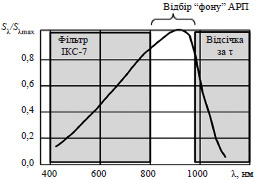Фотоприймальний пристрій підвищеної надійності та тривкості до фонової освітленості для FSO
Анотація
В умовах технології FSO (вільного оптичного простору) актуальним є питання протидії створюваному сонячним світлом фоновому освітленню, здатному згенерувати великий фотострум фотодіода, який може придушити корисний монохроматичний сигнал. У цій роботі пропонується конструкція надійного та тривкого до фонової освітленості фотоприймального пристрою, що працює на довжини хвилі 980 нм, в умовах освітлення сонячним випромінюванням потужністю до 17 мВт. Протидія фотоприймача фоновому освітленню полягає у комбінації оптичного відрізального фільтра, схеми автоматичного регулювання підсилення та алгоритму відбору корисного сигналу за час зростання фотоструму фотодіода на робочій довжині хвилі.
Посилання
Al-Gailani S. A. et al. A survey of free space optics (FSO) communication systems, links, and networks. IEEE Access, 2021, vol. 9, pp. 7353 – 7373. https://doi.org/10.1109/ACCESS.2020.3048049
Mikołajczyk J., Bielecki Z., Bugajski M. et al. Analysis of free-space optics development, Metrol. Measur. Syst., 2017, vol. 24, no. 4, pp. 653 – 674. https://doi.org/10.1515/mms-2017-0060
Ghassemlooy Z. et al. An Overview of Optical Wireless Communications. In: Uysal M., Capsoni C., Ghassemlooy Z., Boucouvalas A., Udvary E. (eds) Optical Wireless Communications. Signals and Communication Technology. Springer, Cham., 2016, pp. 1 – 23. https://doi.org/10.1007/978-3-319-30201-0_1
Dobrovolsky Y., Lipka V. Silicon photodiode for telecommunications (FSO) with increased speed and sensitivity at 980 nm. Herald of Khmelnytskyi National University. Technical Sciences, 2024, vol. 331, no. 1, pp. 205 – 214. https://doi.org/10.31891/2307-5732-2024-331-31 (Ukr)
Rogalski A. Infrared and Terahertz Detectors, CRC Press, 2022. 1066 p. URL: https://www.routledge.com/Infrared-and-Terahertz-Detectors-Third-Edition/Rogalski/p/book/ 9781032338668#top
Machekhin Yu.P., Hnatenko O.S., Kurskyi Yu.S. et al. Lazerni, optyko-elektronni prylady ta systemy. Ch. 1. Lazerna informatsiino-vymiriuvalna tekhnika dlia zadach viiskovoho pryznachennia [Laser, optoelectronic devices and systems. Part 1. Laser information and measuring equipment for military purposes]. Kharkiv: FOP Panov A.M., 2019. 156 p. Available: https://doi.org/10.30837/978-617-7771-76-9 (Ukr)
Chadyuk V. O. Optoelektronika: vid makro do nano. Peredavannya, peretvorennya ta pryymannya optychnoho vyprominyuvannya : navch. posib [Optoelectronics: from macro to nano. Transmission, conversion and reception of optical radiation: a textbook]. In 2 books. Kyiv: Igor Sikorsky Kyiv Polytechnic Institute, Publishing House “Polytechnics”, 2018. Book 1, 376 p. (Ukr)
Trofymenko O. H., Manakov S. YU., Larin D. H. Osnovy prohramnoyi inzheneriyi : navch.-metod. posibnyk [Fundamentals of software engineering: teaching and methodical manual]. Odesa : Feniks, 2022. 197 с. Available: https://hdl.handle.net/11300/22773 (Ukr)
Marnadu R., Chandrasekaran J., Maruthamuthu S. et al. Ultra-high photoresponse with superiorly sensitive metal-insulator-semiconductor (MIS) structured diodes for UV photodetector application. Applied Surface Science, 2019, vol. 30, pp. 308 – 322. https://doi.org/10.1016/j.apsusc.2019.02.214
Kukurudziak M. Silicon four element p-i-n photodiode with improved characteristics. Radioelectronic and Computer Systems, 2023, no. 1, pp. 92 – 100. https://doi.org/10.32620/reks.2023.1.07
Wu Q., Cen G., LiuYu. A simple-structured silicon photodetector possessing asymmetric Schottky junction for NIR imaging. Physics Letters A, 2021, vol. 7, 127586. https://doi.org/10.1016/j.physleta.2021.127586
Setala O.E., Chen K., Pasanen T.P. et al. Boron-implanted black silicon photodiode with close-to-ideal responsivity from 200 to 1000 nm. ACS Photonics 2023, vol. 10, iss. 6, pp. 1735-1741. https://doi.org/10.1021/acsphotonics.2c01984
Dobrovolsky Y., Sorokaty Y. Model and algorithm of creation of silicon photodiod with high sensitivity in the middle infrared area of the spectrum. Radioelectronic and Computer Systems, 2022, no. 4, рp. 98 – 107. https://doi.org/10.32620/reks.2022.4.07
Bi X., Li J., Gu Z. et al. High sensitivity and dynamic-range 25 gbaud silicon receiver chipset with current-controlled DC adjustment path and cube-shape Ge-on-Si PD. IEEE Transactions on Circuits and Systems I: Regular Papers, 2020, vol. 67, iss. 11. https://doi.org/10.1109/TCSI.2020.3011292
Raynor J.M., Seitz P. A linear array of photodetectors with wide dynamic range and near photon quantum-noise limit. Sensors and Actuators A: Physical, 1997, vol. 61, iss. 1 – 3, pp. 327-330. https://doi.org/10.1016/S0924-4247(97)01481-7
Perez A., Pablo Ju., Lopez C. S., Calvo B. Automatic gain control. Techniques and Architectures for RF Receivers. Springer New York, NY, 2011. URL: https://www.springer.com/gp/book/9781461401667
Thomas F. A., Dietz V., Schrafl-Altermatt M. Automatic gain control of neural coupling during cooperative hand movements. Scientific Reports, 2018, vol. 8, article number 5959. https://doi.org/10.1038/s41598-018-24498-6
Veugen L.C.E., Chalupper J., Snik A.F.M. et al. Matching automatic gain control across devices in bimodal cochlear implant users. Ear Hear, 2016, vol. 37, iss. 3, pp. 260 – 70. https://doi.org/10.1097/AUD.0000000000000260
Borowski H., Isoz O., Eklof F.M.et al. detecting false signals with automatic gain control. GPS World Staff, 2012. Available: https://www.gpsworld.com/detecting-false-signals-automatic-gain-control-12804/
Jun Hee Jang, Hyung Jin Choi. A fast automatic gain control scheme for 3GPP LTE TDD system. 2010 IEEE 72nd Vehicular Technology Conference - Fall. Ottawa, ON, Canada, 2010, pp. 1 – 5, https://doi.org/10.1109/VETECF.2010.5594461
Raynor J.M., Seitz P. A linear array of photodetectors with wide dynamic range and near photon quantum-noise limit. Sensors and Actuators A: Physical, 1997, vol. 61, iss. 1 – 3, pp. 327-330. https://doi.org/10.1016/S0924-4247(97)01481-7
Hodovaniouk V.M., Doktorovych I.V., Butenko V.K. et al. Silicon photodiode & preamplifier operation characteristic properties under background radiation conditions. Semiconductor Physics Quantum Electronics & Optoelectronics, 2005, vol. 8, no. 1, pp. 83 – 86. Available: http://journal-spqeo.org.ua/n1_2005/v8n1-p083-086.pdf
Freeman E., Bates B., Sierra K., Robson E. Head First Design Patterns: A Brain-Friendly Guide O’Reilly MediaБ, 2004. 694 p.
Proektuvannya spetsializovanykh mikroprotsesornykh system [Design of specialized microprocessor systems. Textbook – Electronic version]. Compiled by G. I. Vorobets, S. V. Melnychuk. Chernivtsi: Chernivtsi National University, 2022. 105 p. (Ukr)
Dobrovolsky, Y., Lipka, V. High reliability anti-background illumination algorithm for measuring energy illumination produced by a bactericidal irradiator. Herald of Khmelnytskyi National University. Technical Sciences, 2024, vol. 339, no. 4, pp. 64 – 71. https://doi.org/10.31891/2307-5732-2024-339-4-11 (Ukr)
Sze S. M., NgK. K. Physics of Semiconductor Devices. John Wiley & Sons Inc., New Jersey, 2006.
UFD15M-01. Technical specifications. Available: https://zapadpribor.com/en/ufd15m-01/
Yakovyna V. S., Seniv M. M. Osnovy teoriyi nadiynosti prohramnykh system. Navchalʹnyy posibnyk. [Fundamentals of the Theory of Reliability of Software Systems. Textbook]. Lviv : Lviv Polytechnic Publishing House, 2020. 248 p. (Ukr)

Авторське право (c) 2025 Володимир Ліпка, Юрій Добровольський

Ця робота ліцензується відповідно до Creative Commons Attribution 4.0 International License.
